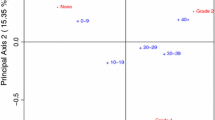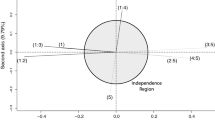Abstract
Non-symmetrical correspondence analysis (NSCA) is a very practical statistical technique for the identification of the structure of association between asymmetrically related categorical variables forming a contingency table. This paper considers some tools that can be used to numerically and graphically explore in detail the association between these variables and include the use of confidence regions, the establishment of the link between NSCA and the analysis of variance of categorical variables, and the effect of imposing linear constraints on a variable.
Similar content being viewed by others
References
AINSWORTH, M.D., BLEHAR, M.C., WATERS, E., and WALL, S. (1978), Patterns of Attachment: A Psychological Study of the Strange Situation, Hillsdale, NJ: Erlbaum.
AGRESTI, A. (1996), An Introduction to Categorical Data Analysis, New York: Wiley.
ANDREWS, D.F. (1972), “Plots of High-dimensional Data”, Biometrics, 28, 125–136.
BAR-HEN, A., and MORTIER, F. (2004), “Influence and Sensitivity Measures in Correspondence Analysis”, Statistics, 38, 207–215.
BEH, E.J. (2001), “Confidence Circles for Correspondence Analysis Using Orthogonal Polynomials”, Journal of Applied Mathematics and Decision Sciences, 5, 35–45.
BEH, E.J. (2004), “Simple Correspondence Analysis: A Bibliographic Review”, International Statistical Review, 72, 257–284.
BENASSENI, J. (1993), “Perturbational Aspects in Correspondence Analysis”, Computational Statistics and Data Analysis, 15, 393–410.
BOCKENHOLT, U., and BOCKENHOLT, I. (1990) “Canonical Analysis of Contingency Tables with Linear Constraints”, Psychometrika, 55, 633–639.
CHERNOFF, H. (1973), “The Use of Faces to Represent Points in K-dimensional Space Graphically”, Journal of the American Statistical Association, 68, 361–368.
CHOULAKIAN, V., and ALLARD, J. (1998), “The Z-plot: A Graphical Procedure for Contingency Tables with an Ordered Response Variable”, in Visualization of Categorical Data, eds. J. Blasius and M. Greenacre, M., London: Academic Press, pp. 99–105.
D’AMBRA L., and LAURO, N. (1989), “Non Symmetrical Analysis of Three Way Contingency Tables”, in Multiway Data Analysis, eds. R. Coppi and S. Bolasco, Amsterdam, New York, Oxford, Toyko: North Holland, pp. 301–315.
D’AMBRA, L., and LAURO, N. (1992), “Exploratory Non Symmetric Data Analysis”, Italian Journal of Applied Statistics, 4, 511–529.
D’AMBRA, L., BEH, E.J., and AMENTA, P. (2005), “CATANOVA for Two-way Contingency Tables with Ordinal Variables Using Orthogonal Polynomials”, Communications in statistics (Theory and Method), 34, 1755–1769.
FRIENDLY, M. (1994), “Mosaic Displays for Multi-way Contingency Tables”, Journal of the American Statistical Association, 89, 190–200.
FRIENDLY, M. (1999), “Extending Mosaic Displays: Marginal, Conditional, and Partial Views of Categorical Data”, Journal of Computational and Graphical Statistics, 8, 373–395.
GABRIEL, K.R. (1971), “The Biplot Graphic Display of Matrices with Application to Principal Component Analysis”, Biometrika, 58, 453–467.
GEORGE, C., KAPLAN, N., and MAIN, M. (1985), Adult Attachment Interview, Unpublished manuscript, University of California, Berkeley.
GOODMAN, L.A. (1986), “Some Useful Extensions of the Usual Correspondence Analysis Approach and the Usual Log-linear Models Approach in the Analysis of Contingency Tables”, International Statistical Review, 54, 243–309.
GOODMAN, L.A., and KRUSKAL, W.H. (1954), “Measures of Association for Crossclassifications”, Journal of the American Statistical Association, 49, 732–764.
GRAY, L.N., and WILLIAMS, J.S. (1975), “Goodman and Kruskals Tau b: Multiple and Partial Analogs”, American Statistical Association (Proceedings of the Social Statistics Section), 444–448.
GREENACRE, M.J. (1984), Theory and Application of Correspondence Analysis, London: Academic Press.
HABERMAN, S.J. (1979), Analysis of Quantitative Data (Vol. 2), New York: Academic Press.
KHATTREE, R., and NAIK, D.N. (2002a), “Andrews Plots for Multivariate Data: Some New Suggestions and Applications”, Journal of Statistical Planning and Inference, 100, 411–425.
KHATTREE, R., and NAIK, D.N. (2002b), “Association in Contingency Tables, Correspondence Analysis, and (Modified) Andrews Plots”, in Goodness-of-Fit Tests and Validity of Models, eds. N. Balakrishnan, C. Huber, M. Nikulin, and M. Mesbah, Boston: Birkhauser, Chap. 23.
KIM, H. (1992), “Measures of Influence in Correspondence Analysis”, Journal of Statistical Planning and Inference, 40, 201–217.
KIM, H. (1994), “Influence Functions in Multiple Correspondence Analysis”, Korean Journal of Applied Statistics, 7, 69–74.
KROONENBERG, P., and LOMBARDO, R. (1999), “Nonsymmetric Correspondence Analysis: A Tool for Analysing Contingency Tables with a Dependence Structure”, Multivariate Behavioral Research, 34, 367–396.
LEBART, L., MORINEAU, A., and WARWICK, K.M. (1984) Multivariate Descriptive Statistical Analysis, New York: John Wiley & Sons.
LIGHT, R.J. and MARGOLIN, B.H. (1971), “An Analysis of Variance for Categorical Data”, Journal of the American Statistical Association, 66, 534–544.
LOMBARDO, R., BEH, E.J., and D’AMBRA, L. (2007), “Non-symmetric Correspondence Analysis with Ordinal Variables”, Computational Statistics and Data Analysis, 52, 566–577.
LOMBARDO, R., CARLIER, A., and D’AMBRA, L. (1996), “Nonsymmetric Correspondence Analysis for Three-way Contingency Tables”, Methodologica, 4, 59–80.
MARCOTORCHINO, F. (1985), Utilisation des Comparaisons par Paires en Statistique de Contingencies: Parte III, Report # F 071, Etude du Centre Scientifique, IBM, France.
MARDIA, K.V., KENT, J.T., and BIBBY, J.M. (1982), Multivariate Analysis, London: Academic Press.
RINGROSE, T.J. (1992), “Bootstrapping and Correspondence Analysis in Archaeology”, Journal of Archaeological Science, 19, 615–629.
RINGROSE, T.J. (1996), “Alternative Confidence Regions for Canonical Variate Analysis”, Biometrika, 83, 575–587.
ROVAN, J. (1994), “Visualizing Solutions in More Than Two Dimensions”, in Correspondence Analysis in the Social Sciences, eds M. Greenacre and J. Blasius, London: Academic Press, pp. 210–229.
SINGH, B. (1996), “On CATANOVA Method for Analysis of Two-way Classified Nominal Data”, Sankhya B, 58, 379–388.
TAKANE, Y., and SHIBAYAMA, T. (1991), “Principal Component Analysis with External Information on Both Subjects and Variables”, Psychometrika, 56, 97–120.
TAKANE, Y., YANAI, H., and MAYEKAWA, S. (1991), Relationships Among Several Methods of Linearly Constrained Correspondence Analysis, Psychometrika, 56, 667–684.
TALLUR, B. (1986), “Un nouvel indice d’agregation en classification ascendant hierarchique”. Revue de Statistique Appliquèe, 34 (2), 25–35.
VAN IJZENDOORN, M.H. (1995), “Adult Attachment Representations, Parental Responsiveness, and Infant Attachment. A Meta-analysis on the Predictive Validity of the Adult Attachment Interview”, Psychological Bulletin, 117, 387–403.
Author information
Authors and Affiliations
Corresponding author
Additional information
The authors would like to thank the anonymous referees for their comments and suggestions during the preparation of this paper.
Rights and permissions
About this article
Cite this article
Beh, E.J., D’Ambra, L. Some Interpretative Tools for Non-Symmetrical Correspondence Analysis. J Classif 26, 55–76 (2009). https://doi.org/10.1007/s00357-009-9025-0
Published:
Issue Date:
DOI: https://doi.org/10.1007/s00357-009-9025-0




